Gauge sizes, often denoted as “gage, delineate the thickness of sheet metal, employing a hierarchy where higher numbers signify diminished thickness. The genesis of this complexity lies in the distinct gauge size standards, each meticulously calibrated to correspond with the weight of sheet metal across varied materials. Notably, the esteemed Manufacturers’ Standard Gage emerges as a stalwart, furnishing precise thicknesses for the stalwart trio of standard steel, galvanized steel, and stainless steel.
A bespoke standard materializes for Zinc, wherein gauge numbers ascend concomitantly with sheet thickness, offering a succinct metric for assessment.

U.S. Standard Gauge Size for Sheet & Plate Iron / Steel
This Standard Sheet & Plate Metal Gauge Size Chart for Iron and Steel offers a clear overview of gauge sizes, each meticulously calibrated to denote varying thickness levels.
15 U.S.C.
United States Code, 2010 Edition
Title 15 – Commerce and Trade
Chapter 6 – Weights and Measures and Standard Time
Subchapter Iii – Standard Gauge for Iron and Steel
| Iron and Steel | Approximate Thickness | Weight Per Area | ||
|---|---|---|---|---|
| Number of Gauge | in | mm | lb/ft2 | kg/m2 |
| 0000000 | 1/2 | 12.7 | 20.00 | 97.65 |
| 000000 | 15/32 | 11.906 | 18.75 | 91.55 |
| 00000 | 7/16 | 11.113 | 17.50 | 85.44 |
| 0000 | 13/32 | 10.319 | 16.25 | 79.33 |
| 000 | 3/8 | 9.525 | 15 | 73.24 |
| 00 | 11/32 | 8.731 | 13.75 | 67.13 |
| 0 | 5/16 | 7.938 | 12.50 | 61.03 |
| 1 | 9/32 | 7.144 | 11.25 | 54.93 |
| 2 | 17/64 | 6.747 | 10.625 | 51.88 |
| 3 | 1/4 | 6.350 | 10 | 48.82 |
| 4 | 15/64 | 5.953 | 9.375 | 45.77 |
| 5 | 7/32 | 5.556 | 8.75 | 42.72 |
| 6 | 13/64 | 5.159 | 8.125 | 39.67 |
| 7 | 3/16 | 4.763 | 7.5 | 36.62 |
| 8 | 11/64 | 4.366 | 6.875 | 33.57 |
| 9 | 5/32 | 3.969 | 6.25 | 30.52 |
| 10 | 9/64 | 3.572 | 5.625 | 27.46 |
| 11 | 1/8 | 3.175 | 5 | 24.41 |
| 12 | 7/64 | 2.778 | 4.375 | 21.36 |
| 13 | 3/32 | 2.381 | 3.75 | 18.31 |
| 14 | 5/64 | 1.984 | 3.125 | 15.26 |
| 15 | 9/128 | 1.786 | 2.8125 | 13.73 |
| 16 | 1/16 | 1.588 | 2.5 | 12.21 |
| 17 | 9/160 | 1.429 | 2.25 | 10.99 |
| 18 | 1/20 | 1.270 | 2 | 9.765 |
| 19 | 7/160 | 1.111 | 1.75 | 8.544 |
| 20 | 3/80 | 0.953 | 1.50 | 7.324 |
| 21 | 11/320 | 0.873 | 1.375 | 6.713 |
| 22 | 1/32 | 0.794 | 1.25 | 6.103 |
| 23 | 9/320 | 0.714 | 1.125 | 5.493 |
| 24 | 1/40 | 0.635 | 1 | 4.882 |
| 25 | 7/320 | 0.556 | 0.875 | 4.272 |
| 26 | 3/160 | 0.476 | 0.75 | 3.662 |
| 27 | 11/640 | 0.437 | 0.6875 | 3.357 |
| 28 | 1/64 | 0.397 | 0.625 | 3.052 |
| 29 | 9/640 | 0.357 | 0.5625 | 2.746 |
| 30 | 1/80 | 0.318 | 0.5 | 2.441 |
| 31 | 7/640 | 0.278 | 0.4375 | 2.136 |
| 32 | 13/1280 | 0.258 | 0.4063 | 1.983 |
| 33 | 3/320 | 0.238 | 0.375 | 1.831 |
| 34 | 11/1280 | 0.218 | 0.3438 | 1.678 |
| 35 | 5/640 | 0.198 | 0.3125 | 1.526 |
| 36 | 9/1280 | 0.179 | 0.2813 | 1.373 |
| 37 | 17/2560 | 0.169 | 0.2656 | 1.297 |
| 38 | 1/160 | 0.159 | 0.25 | 1.221 |
Whether you’re a seasoned professional or a newcomer to the field, this chart serves as an indispensable resource for navigating the intricate realm of sheet metal gauges with ease and accuracy.
Gauge Size Chart for Stainless Steel
This Stainless Steel Sheet Metal Gauge Size Chart delivers a concise breakdown of gauge numbers and corresponding sheet thicknesses, ensuring clarity and efficiency in your operations.
| Stainless Steel | Thickness | |
|---|---|---|
| Gauge | Approximate thickness, in | Approximate thickness, mm |
| 7 | 0.1875 | 4.76 |
| 8 | 0.1719 | 4.37 |
| 9 | 0.1563 | 3.97 |
| 10 | 0.1406 | 3.57 |
| 11 | 0.1250 | 3.18 |
| 12 | 0.1094 | 2.78 |
| 13 | 0.0940 | 2.40 |
| 14 | 0.0781 | 1.98 |
| 15 | 0.0700 | 1.80 |
| 16 | 0.0625 | 1.59 |
| 17 | 0.0560 | 1.40 |
| 18 | 0.0500 | 1.27 |
| 19 | 0.0440 | 1.10 |
| 20 | 0.0375 | 0.95 |
| 21 | 0.0340 | 0.86 |
| 22 | 0.0310 | 0.79 |
| 23 | 0.0280 | 0.71 |
| 24 | 0.0250 | 0.64 |
| 25 | 0.0220 | 0.56 |
| 26 | 0.0190 | 0.48 |
| 27 | 0.0170 | 0.43 |
| 28 | 0.0160 | 0.41 |
| 29 | 0.0140 | 0.36 |
| 30 | 0.0130 | 0.33 |
| 31 | 0.0110 | 0.28 |

Gauge Size Chart for Galvanized Steel
Explore this Sheet Metal Gauge Size Chart for Galvanized Steel, a concise reference providing essential insights into the thickness variations of galvanized steel sheets.
| Galvanized Steel | Thickness | Weight Per Area | ||
|---|---|---|---|---|
| Gauge | in | mm | lb/ft2 | kg/m2 |
| 8 | 0.1681 | 4.270 | 6.858 | 33.482 |
| 9 | 0.1532 | 3.891 | 6.250 | 30.514 |
| 10 | 0.1382 | 3.510 | 5.638 | 27.527 |
| 11 | 0.1233 | 3.132 | 5.030 | 24.559 |
| 12 | 0.1084 | 2.753 | 4.422 | 21.591 |
| 13 | 0.0934 | 2.372 | 3.810 | 18.603 |
| 14 | 0.0785 | 1.994 | 3.202 | 15.636 |
| 15 | 0.0710 | 1.803 | 2.896 | 14.142 |
| 16 | 0.0635 | 1.613 | 2.590 | 12.648 |
| 17 | 0.0575 | 1.461 | 2.346 | 11.453 |
| 18 | 0.0516 | 1.311 | 2.105 | 10.278 |
| 19 | 0.0456 | 1.158 | 1.860 | 9.083 |
| 20 | 0.0396 | 1.006 | 1.615 | 7.888 |
| 21 | 0.0366 | 0.930 | 1.493 | 7.290 |
| 22 | 0.0336 | 0.853 | 1.371 | 6.692 |
| 23 | 0.0306 | 0.777 | 1.248 | 6.095 |
| 24 | 0.0276 | 0.701 | 1.126 | 5.497 |
| 25 | 0.0247 | 0.627 | 1.008 | 4.920 |
| 26 | 0.0217 | 0.551 | 0.885 | 4.322 |
| 27 | 0.0202 | 0.513 | 0.824 | 4.023 |
| 28 | 0.0187 | 0.475 | 0.763 | 3.725 |
| 29 | 0.0172 | 0.437 | 0.702 | 3.426 |
| 30 | 0.0157 | 0.399 | 0.640 | 3.127 |
| 31 | 0.0142 | 0.361 | 0.579 | 2.828 |
| 32 | 0.0134 | 0.340 | 0.547 | 2.669 |

This chart condenses complex gauge measurements into a user-friendly format, empowering users to make informed decisions swiftly and effectively.
Gauge Size Chart for Aluminum
This Gauge Size Chart provides information on aluminum sheet metal thicknesses. It presents gauge numbers and their corresponding sheet thicknesses, offering practical guidance for metalworking tasks.
| Aluminum | Thickness | Weight Per Area | ||
|---|---|---|---|---|
| Gauge | in | mm | lb/ft2 | kg/m2 |
| 000000 | 0.5800 | 14.732 | 8.185 | 39.96 |
| 00000 | 0.5165 | 13.119 | 7.289 | 35.59 |
| 0000 | 0.4600 | 11.684 | 6.492 | 31.69 |
| 000 | 0.4096 | 10.404 | 5.780 | 28.22 |
| 00 | 0.3648 | 9.266 | 5.148 | 25.14 |
| 0 | 0.3249 | 8.252 | 4.585 | 22.39 |
| 1 | 0.2893 | 7.348 | 4.083 | 19.93 |
| 2 | 0.2576 | 6.543 | 3.635 | 17.75 |
| 3 | 0.2294 | 5.827 | 3.237 | 15.81 |
| 4 | 0.2043 | 5.189 | 2.883 | 14.07 |
| 5 | 0.1819 | 4.620 | 2.567 | 12.53 |
| 6 | 0.1620 | 4.115 | 2.286 | 11.16 |
| 7 | 0.1443 | 3.665 | 2.036 | 9.942 |
| 8 | 0.1285 | 3.264 | 1.813 | 8.854 |
| 9 | 0.1144 | 2.906 | 1.614 | 7.882 |
| 10 | 0.1019 | 2.588 | 1.438 | 7.021 |
| 11 | 0.0907 | 2.304 | 1.280 | 6.249 |
| 12 | 0.0808 | 2.052 | 1.140 | 5.567 |
| 13 | 0.0720 | 1.829 | 1.016 | 4.961 |
| 14 | 0.0641 | 1.628 | 0.905 | 4.417 |
| 15 | 0.0571 | 1.450 | 0.806 | 3.934 |
| 16 | 0.0508 | 1.290 | 0.717 | 3.500 |
| 17 | 0.0453 | 1.151 | 0.639 | 3.121 |
| 18 | 0.0403 | 1.024 | 0.569 | 2.777 |
| 19 | 0.0359 | 0.912 | 0.507 | 2.474 |
| 20 | 0.0320 | 0.813 | 0.452 | 2.205 |
| 21 | 0.0285 | 0.724 | 0.402 | 1.964 |
| 22 | 0.0253 | 0.643 | 0.357 | 1.743 |
| 23 | 0.0226 | 0.574 | 0.319 | 1.557 |
| 24 | 0.0201 | 0.511 | 0.284 | 1.385 |
| 25 | 0.0179 | 0.455 | 0.253 | 1.233 |
| 26 | 0.0159 | 0.404 | 0.224 | 1.096 |
| 27 | 0.0142 | 0.361 | 0.200 | 0.978 |
| 28 | 0.0126 | 0.320 | 0.178 | 0.868 |
| 29 | 0.0113 | 0.287 | 0.159 | 0.779 |
| 30 | 0.0100 | 0.254 | 0.141 | 0.689 |
| 31 | 0.0089 | 0.226 | 0.126 | 0.613 |
| 32 | 0.0080 | 0.203 | 0.113 | 0.551 |
| 33 | 0.0071 | 0.180 | 0.100 | 0.489 |
| 34 | 0.0063 | 0.160 | 0.089 | 0.434 |
| 35 | 0.0056 | 0.142 | 0.079 | 0.386 |
| 36 | 0.0050 | 0.127 | 0.071 | 0.345 |
| 37 | 0.0045 | 0.114 | 0.064 | 0.310 |
| 38 | 0.0040 | 0.102 | 0.056 | 0.276 |
| 39 | 0.0035 | 0.089 | 0.049 | 0.241 |
| 40 | 0.0031 | 0.079 | 0.044 | 0.214 |
Gauge Size Chart for Zink
This Zinc Gauge Size Chart offers a straightforward reference for understanding sheet metal thicknesses. It presents gauge numbers alongside corresponding sheet thicknesses for zinc, providing practical guidance for metalworking projects.
| Zink | Thickness | Weight Per Area | ||
|---|---|---|---|---|
| Gauge | in | mm | lb/ft2 | kg/m2 |
| 28 | 1.000 | 25.40 | 37.15 | 181.39 |
| 27 | 0.500 | 12.70 | 18.58 | 90.70 |
| 26 | 0.375 | 9.525 | 13.93 | 68.02 |
| 25 | 0.250 | 6.350 | 9.288 | 45.35 |
| 24 | 0.125 | 3.175 | 4.644 | 22.67 |
| 23 | 0.100 | 2.540 | 3.715 | 18.14 |
| 22 | 0.090 | 2.286 | 3.344 | 16.33 |
| 21 | 0.080 | 2.032 | 2.972 | 14.51 |
| 20 | 0.070 | 1.778 | 2.601 | 12.70 |
| 19 | 0.060 | 1.524 | 2.229 | 10.88 |
| 18 | 0.055 | 1.397 | 2.043 | 9.977 |
| 17 | 0.050 | 1.270 | 1.858 | 9.070 |
| 16 | 0.045 | 1.143 | 1.672 | 8.163 |
| 15 | 0.040 | 1.016 | 1.486 | 7.256 |
| 14 | 0.036 | 0.914 | 1.337 | 6.530 |
| 13 | 0.032 | 0.813 | 1.189 | 5.805 |
| 12 | 0.028 | 0.711 | 1.040 | 5.079 |
| 11 | 0.024 | 0.610 | 0.892 | 4.353 |
| 10 | 0.020 | 0.508 | 0.743 | 3.628 |
| 9 | 0.018 | 0.457 | 0.669 | 3.265 |
| 8 | 0.016 | 0.406 | 0.594 | 2.902 |
| 7 | 0.014 | 0.356 | 0.520 | 2.539 |
| 6 | 0.012 | 0.305 | 0.446 | 2.177 |
| 5 | 0.010 | 0.254 | 0.372 | 1.814 |
| 4 | 0.008 | 0.203 | 0.297 | 1.451 |
| 3 | 0.006 | 0.152 | 0.223 | 1.088 |
| 2 | 0.004 | 0.102 | 0.149 | 0.726 |
| 1 | 0.002 | 0.051 | 0.074 | 0.363 |
Sheet Metal Thickness Measurement
Several tools are commonly used for measuring metal gauge thickness:
Calipers
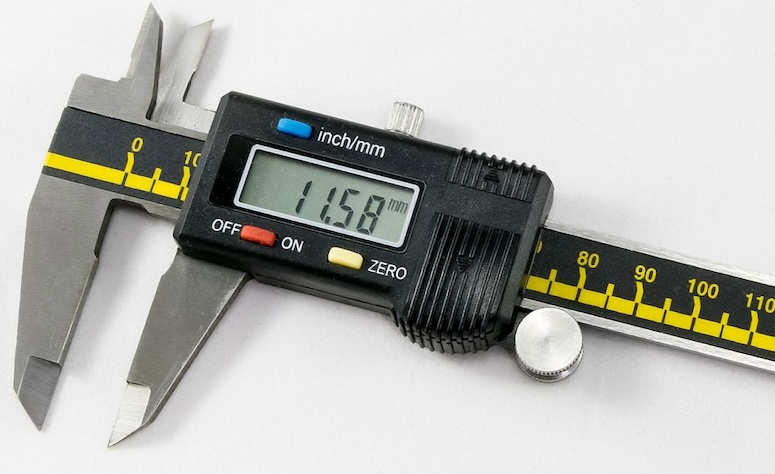
Digital or Vernier calipers can measure the thickness of metal accurately. These tools have fine adjustments and can measure thickness to within a fraction of a millimeter.
Micrometer
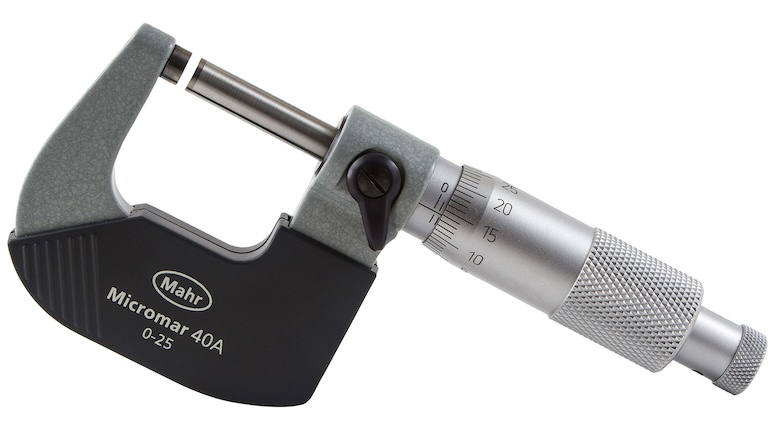
A micrometer is a precision tool used for very accurate measurements. It can measure metal thickness with high precision, typically to within a thousandth of an inch or hundredth of a millimeter.
Thickness Gauges
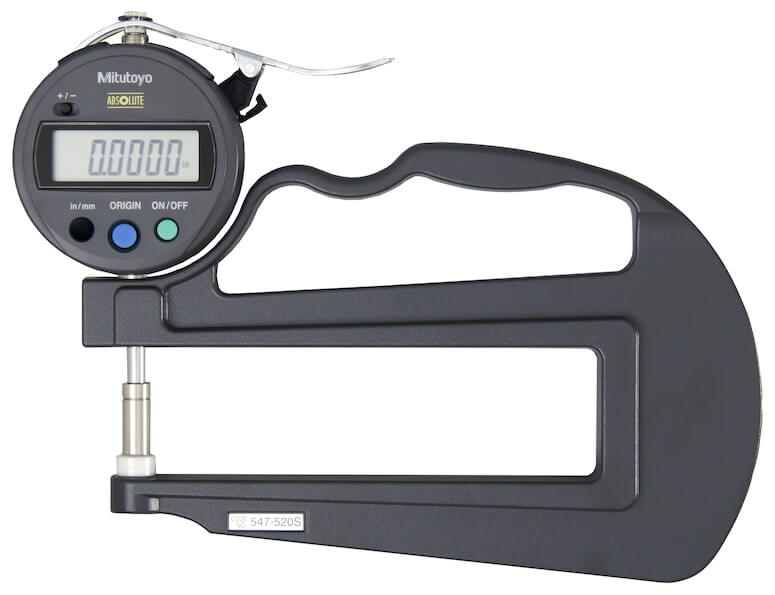
These gauges are specifically designed for measuring the thickness of sheet metal. They come in various forms, including mechanical dial gauges and digital models, and are available in different ranges to accommodate various thicknesses.
Ultrasonic Thickness Gauges
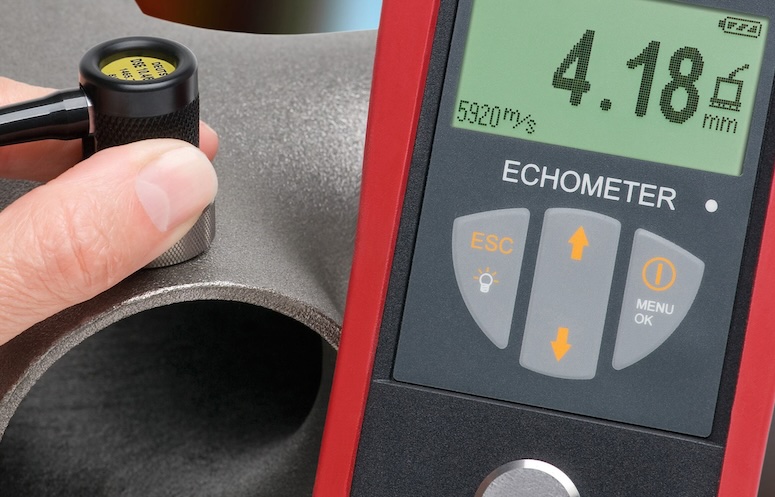
These gauges use ultrasonic waves to measure metal thickness. They are particularly useful for measuring the thickness of metals that are difficult to access or where non-destructive testing is required.
Feeler Gauges
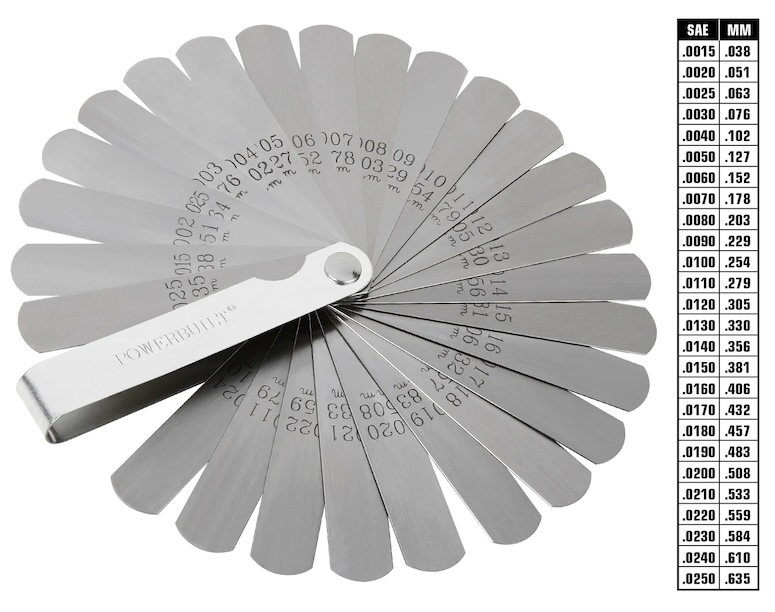
While primarily used for measuring small gaps and clearances, feeler gauges can also be used to measure the thickness of thin metal sheets.
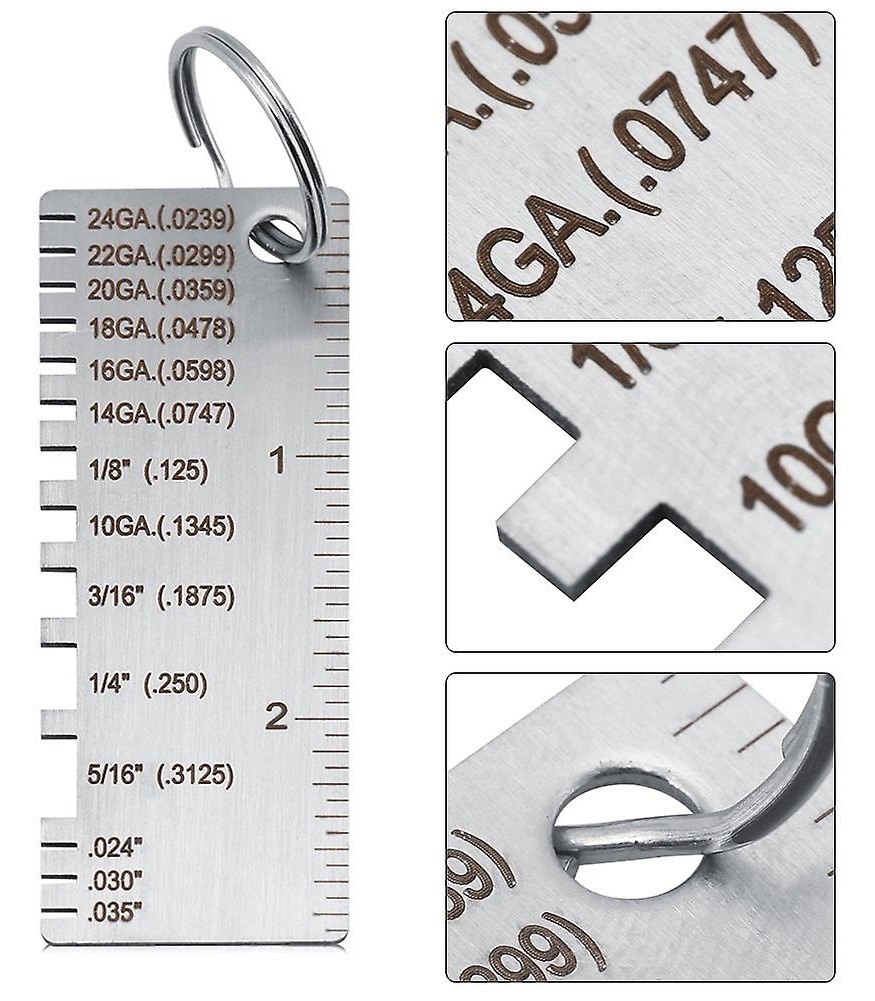
A gauge chart, like the one we mentioned earlier, provides a reference table that correlates gauge numbers with corresponding thicknesses in inches or millimeters. While not a direct measurement tool, it’s invaluable for quickly determining thickness based on gauge number. Each of these tools has its advantages and is suitable for different applications, depending on the required precision, accessibility, and budget.






Do these data depend greatly on the grade of steel, if we are talking about stainless steel?
For 95% of stainless steel grades, the gauge sizes from this table will be the same!
Why does stainless steel measurement start with gauge “7” and not “000000”?
Stainless steel measurement starting with gauge “7” instead of “000000” is due to the historical development of gauge systems. The gauge numbering for stainless steel and other materials is based on specific standards that have evolved over time. In the case of stainless steel, the gauge numbering typically starts at a higher number like “7” because it corresponds to a specific thickness range that is commonly used in various applications. This numbering system simplifies the representation of thickness and is a standardized way to categorize different thickness levels of stainless steel.